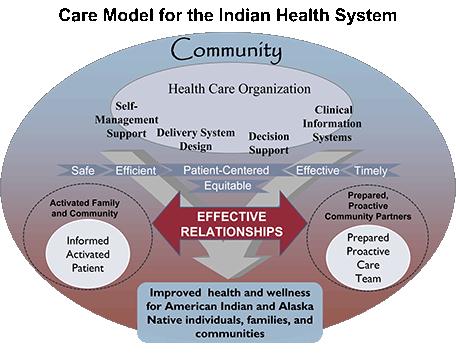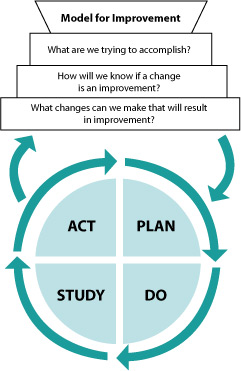IPC Tools and Resources
The IPC Care Model 
The Indian health system has developed an expanded version of the Chronic Care Model, the IPC Care Model (shown on right), designed in particular to be relevant to the populations served by IHS, Tribal, and Urban Indian healthcare programs. It places an emphasis and importance on the “Community” component and focuses on the development of “Effective Relationships between the care team and the patient/family/community. The primary outcome is “Improved Health and Wellness for American Indian and Alaska Native individuals, families, and communities.
The Model for Improvement
The Model for Improvement, developed by Associates in Process Improvement (Langley, 2009) is a tool for accelerating improvement. The Model has two parts. The top half of the diagram asks three questions, and the bottom half portrays a cycle of actions. The model asks three fundamental questions that can be addressed in any order:

What are we trying to accomplish? Improvement requires setting aims, which should be time specific, measureable, and define the specific population of patients that will be affected.
How will we know that a change is an improvement? Teams use quantitative measures to determine if a specific change actually leads to improvement.
What change can we make that will result in improvement? All improvement requires making changes, but not all changes result in improvement. Organizations, therefore, must identify the changes that are most likely to result in improvement.
The Plan-Do-Study-Act (PDSA) cycle (Deming, 2000) tests and implements changes in real work settings – by planning it, trying it, observing the results, and acting on what is learned. The PDSA cycle guides the test of change to determine if the change is an improvement. After testing a change on a small scale, learning from each test, and refining the change through several PDSA cycles, the team can implement the change on a broader scale, for example, for an entire pilot population or for an entire unit.
Deming, W.E. (2000). The new economics for industry, government, and education (2nd ed.). The plan-do-study-act cycle. Cambridge, MA: Massachusetts Institute of Technology (original work published 1994).
Langly, G.L., Nolan, K.M., Nolan, T.W., Norman, C.L., Provost, L.P. (2009). The improvement guide: A practical approach to enhancing organizational performance (2nd ed.). San Francisco, CA: Josey-Bass
The Patient-Centered Medical Home
The medical home is an accessible and patient-centered system of care that provides safe, timely, effective, efficient, and equitable care. The IPC Care Model serves as a framework to guide the creation of a patient-centered medical home for the Indian health system. Sites that achieve a basic level of the patient-centered medical home:
- Deliver care through care teams
- Have improved continuity of care
- Have created partnerships with patients, community, and Tribal organizations
- Have integrated improvement into the overall aim and focus of the organization
The 7 Step Meeting Process (PDF 535KB)
IPC Brochure (PDF 908KB)


 California Area Office
California Area Office